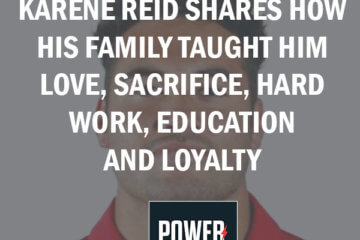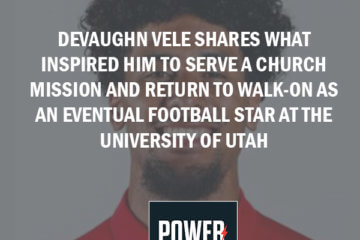Listen to the podcast here:
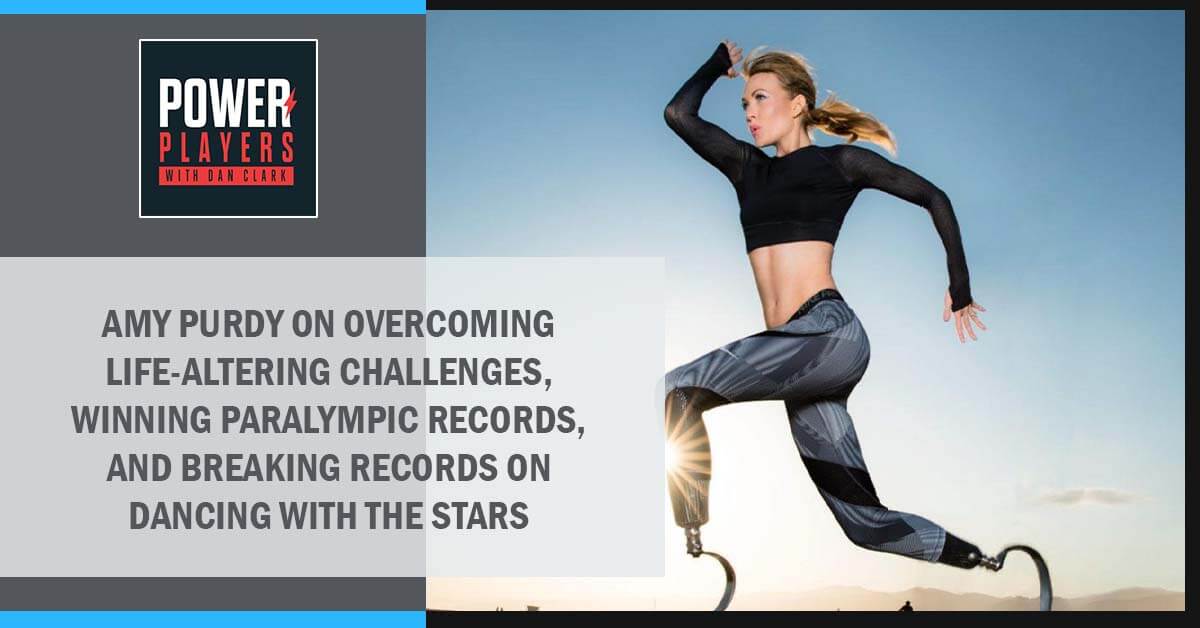
Find your strength in every trial that life throws at you. In this episode, Amy Purdy shares her life and relentless focus on overcoming every obstacle that allowed her to become an Olympic athlete – giving us an inside glimpse of how to never say never – no matter what! Amy is an actress, model, para-snowboarder, motivational speaker, clothing designer, and author. She became a household name when she made it to the finals of Dancing With The Stars – having had both legs amputated!
—
Amy Purdy On Overcoming Life-Altering Challenges, Winning Paralympic Records, And Breaking Records On Dancing With The Stars
In this episode, Amy Purdy, who became a household name when she made it to the finals of Dancing With The Stars, having had both legs amputated, shares her life and relentless focus on becoming an Olympic athlete, overcoming every obstacle that she faced. She gives us an inside glimpse of how to never say never, no matter what. Let’s get right to the questions, if I may, my friend and talk about these three pieces. When and how did you first realize that you had this unconquerable desire to get back up and go again, nothing could get you down and that resiliency was part of your DNA?
It took going through the biggest challenge of my life, being completely broken down, losing my legs, losing my health, thinking that I was going to lose the life that I wanted to live for me to find myself and the things that kept me going. I’ll say that the first thing was I love snowboarding. I grew up snowboarding. It was something that I wanted to do for the rest of my life. I had this passion for it. When I was in the hospital, I lost my kidney function, spleen, hearing in my left ear and both of my legs below the knees to septic shock. I almost lost my life. I fought for my life for a couple of months and I was in a coma. I was on life support and I had less than a 2% chance of living but what I always had was this passion for snowboarding.
I didn’t know, at that time. It was in my DNA to get back up and keep going. I didn’t even think about resiliency or the word resiliency at that time or how strong I was being. First of all, I was surviving and it’s interesting, when you go through something so major and you’re surviving, for me, I feel like my emotions were a little bit detached from trying to survive. I think that probably is a survival technique and something that came into play at that time. I didn’t cry. I was very practical looking up the facts like, “I lost my legs. I was a massage therapist and I wanted to be able to continue to do that. I wanted to be able to travel the world and snowboard.” All I cared about was snowboarding.
All I cared about was, “How am I going to do this again?” In fact, I didn’t even think about walking as much as I did snowboarding. In a way, I skipped through the walking part so I could get to the snowboarding part. Looking back, I did and I went through so much. I lost my legs, my kidneys and the hearing in my left ear all at the same time. I love the three Ps because I would throw in their patience. I learned a lot of patience but patience is what got me through a lot of it because I had this passion but it took time to get there. I had to be another P, Presence. I had to be present. This is what it is but I could daydream about what I wanted to do. I had to learn patience to get to the point where I was doing it.
Would you agree that adversity introduces us to ourselves? That no one will ever know how strong we are until being strong is our only choice?
I say the exact same thing, “You don’t know your own strength until you’re forced to use it or until you’re forced to find it.” When I was young, I was very sensitive. I wasn’t an athlete. I did not grow up as an athlete. I was an artist. I painted, loved music and photography. That’s how I started snowboarding because all of my friends who were artists as well were also skateboarders and snowboarders. They are who got me into snowboarding.
You don’t know your own strength until you’re forced to use it or find it.
It’s not like I was raised an athlete and raised even with the benefits of sport, which I eventually did learn as I became a Paralympic athlete. I realized how important sport is for building resiliency because you’re constantly falling and having to pick yourself back up and keep going. Adversity could be our biggest enemy or it could be our biggest ally. It is making the choice of how you’re going to use it. I feel that the biggest drive in my life is I am faced with adversity every single day and I can’t change it. I have to put my legs on every single day so what am I going to do with this?
As we glued ourselves to the television watching Dancing With The Stars and being in the live audience on one of your performances, I couldn’t help write down, “Pain as a signal to grow, not to suffer.” Once we learned the lesson that pain is teaching us, the pain goes away. There are no mistakes, only lessons.
Teach us what we need to know. Maybe there’s a step-by-step process as a professional speaker, as an ambassador of resiliency or as this master motivator. Have you quantified any process that you went through like step 1, step 2, step 3 of how to get back up and go again? I don’t want to put you on the spot because your life is a step-by-step snapshot but have you quantified anything that we could pass on to our readers?
When I first went through everything I went through and some of this comes into play with Dancing With The Stars and the challenges I faced there as well. When I look back at hitting rock bottom and for me, that was losing both legs, having to have a kidney transplant, which was terrifying and also losing the hearing in my left ear. That was so overwhelming. You could easily lay in bed and not get back up. There was no roadmap to where I wanted to go. I wanted to live a life of adventure. I was the same person that I was before but now everything was so much more complicated and overwhelming.
Looking back, I realized that there were these little techniques that I put into play that I learned along the way. Nobody taught them to me. It’s almost like I had to be in this rock bottom position to figure out my way out of it. One of those techniques is I learned how to compartmentalize because if you look at something and it could be anything. Something that you need to tackle, a challenge that you’re facing. It could be a challenge that you choose or a challenge that chooses you. You have this massive challenge that you want to tackle and it can seem so overwhelming that it’s hard to even get started. You don’t even know where to go with it.
For me, facing a kidney transplant, losing my legs and hearing loss at the same time, I had to break it up into little pieces so that I could chip away at it. Absorb everything that was going on and eventually move forward. Learning to walk again on two prosthetic legs, that alone was so challenging and I’m relearning right now because I had a major injury this 2020 and I’m starting over from scratch. I’m reminded right now how hard this process is alone because your body is not made to stand up on two prosthetic legs. It’s barbaric. They’re made of steel and carbon fiber. The legs are made of muscle soft tissue and bone. Nothing is comfortable about it.
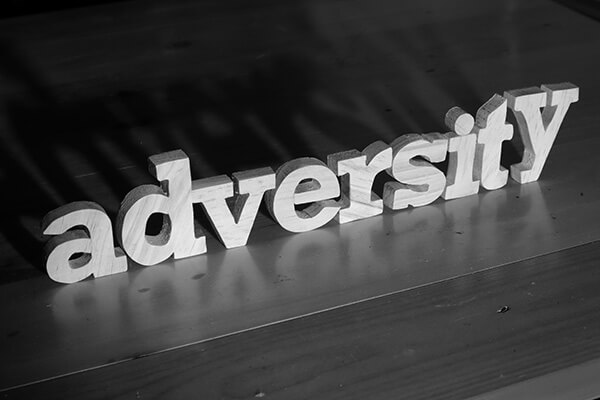
Overcoming Challenges: Adversity could be our biggest enemy or our biggest ally. It’s making the choice of how you’re going to use it.
In order to get through all of this at once, I had to, like, “One day I would focus only on one thing, which was now, I’m focused on my legs. Making new legs, learning to walk and whatever I need to do to get through that.” The next day was, I had to have a kidney transplant. I did my doctor’s appointments and got my blood drawn. I did research and whatever I needed to do to wrap my head around the fact I was having a kidney transplant, which was also huge for me. It was more terrifying than losing my legs because it was my health. It was the rest of my life. It wasn’t a fix.
It was something that I was taking on this challenge with immunosuppressive medication. It could fail. There is so much fear going into it. I would dedicate one day to working on my transplant and anything to wrap my head around it. On the third day, I’m also dealing with hearing loss. If I had to go to a doctor to see if I needed a hearing aid or if I was going to do research on it or whatever, I would do that on the third day.
I allowed myself to slowly chip away at these challenges without allowing myself to get overwhelmed. Looking back, that’s one of the best techniques that I used. With everything going on, it can feel like the world is crashing down and you can stack these problems on top of each other and get crushed under them. You can also step outside of it and organize it like, “Now, I’m jumping into this issue and I’ll see what I can get through. Tomorrow, I jump into that one.” You organize throughout the weekend.
Before you know it, these little baby steps led to these giant leaps that led to me being able to do figure out my hearing, have a successful kidney transplant, not just learn to walk but snowboard and do all the things that I’ve gone on to do. It’s taking these little tiny baby steps and going back to being present and what lesson am I learning right now that I can use to make me stronger in the future and being patient and knowing that if you can see it then you can achieve it.
Another big thing for me was visualization. I never called it visualization. That’s the fancy term for it these days but to be honest, I daydreamed a lot. I had a lot of time to daydream because I was lying in bed without my legs wondering what my future held, what it was going to be like and if I was going to be able to do the things that I loved again. I found myself visualizing the future.
There was one night where I was feeling so much anxiety. The kind of anxiety that crushes you. It’s like a panic attack of like, “This is my life. What am I going to do with my life?” Nobody can help me and tell me that it’s going to be okay. I asked myself this question, “If my life was a book and I was the author, how would I want the story to go?” The reason I asked myself that question was I thought, “I feel so out of control of my situation right now. How can I find some control?” I thought, “What if I could create my future? What if I could finish the story? What would the ideal situation be?”
We can’t always control what happens, but we can always control what happens next.
What I was seeing and experiencing was I lost my legs. People felt sorry for me. I didn’t want to feel sorry for myself and I had no idea what I was capable of. I thought, “What if I could finish this story? The ideal situation, what would it look like?” I saw myself walking gracefully. I saw myself somehow helping other people through this journey and through the things that I learned. I saw myself snowboarding again.
I didn’t see myself carving down this mountain of powder. I visualized it so strongly that I could feel it. I could feel the wind against my face. I could feel the beat of my racing heart. I felt it as if it was happening in that very second. For me, that’s when this whole new chapter of my life began because I saw it. I didn’t see it and hope for it but I felt it in my heart. I thought, “If I can see it and I can believe it then there’s got to be a way that I can achieve this. I’ve got to be able to do this.”
Visualizing has always played a huge role in my life whether it was when I lost my legs, trying to figure out my future or be a professional snowboarder standing up at the top of a racecourse, getting ready to pull out of the race gates or Dancing With The Stars. I’m sitting back trying to visualize the millions of steps that I need to take when I can’t even feel my feet on the floor. Visualizing has been huge for me.
You said so many things and to recap a little bit before we move on. Walt Disney was the first one who said what you said and that is, “Seeing isn’t believing but believing is seeing.” I also wrote down that we can’t always control what happens but we can always control what happens next.
It’s so funny because I said that in a speech.
I wrote down, “Don’t let what you cannot do interfere with what you can do.” From a marriage perspective, you losing part of your hearing is probably one of the reasons why you’ve been happily married for so long. Trust me, that’s a blessing.

Overcoming Challenges: If you see and believe in it, there’s a way for you to achieve it.
You have to find the benefits, you really do. My husband’s snores. All I have to do is roll over to my right side and I can shut it all out.
Let’s get to the next P because I’m fascinated. Your father, whom I’ve never met but I can only imagine what a superhuman he is. He’s the perfect match. He’s the one that donates his kidney for your kidney transplant. That brings us to the second P that qualifies you and everyone who wants to be a power player. It’s the preparation.
The question, Amy, is who inspired you to prepare? How did your parents and your support system play into this? What did they specifically say or do to not enable you to complain or blame but to take 100% responsibility for your life? That’s one of the things that I talk about you behind your back is that of all the people I’ve ever met, you are one who has taken 100% responsibility for your life, the ups and downs. Let’s talk a little bit about preparation and how your support system played into that.
First of all, my family is amazing. They have been amazing through everything. They never left my side. We got very lucky that when I was in the hospital, my sister knew the CEO of the hospital and he allowed my family to have an ICU room right next door to mine, which my parents moved into. We got lucky that there weren’t visiting hours. My family could be by my side 24/7 and knowing that I wasn’t alone. Knowing that I had love and support no matter what. That was huge. That gave me a foundation of confidence that if nothing else, I’ve got my family and I’ve got love and support.
I don’t know if this is me being rebellious but my family went through a lot of emotional stuff. They saw me almost die. They were the ones sitting on the edges of their seats every day to hear back from a doctor after surgery to see if I survived it. They went through these major emotional ups and downs. I remember seeing how broken they all were. My mom was heartbroken. The fact that I lost both of my legs, she had so many questions like, “Could I be a mother? How am I going to get around on two prosthetic legs? I love to hike and I’m a massage therapist. I snowboard.”
My family took on so much and I saw that heartbreak in their faces every single day. I didn’t want them to be sad. I kept feeling like I’m going to be okay. I am going to show them that I’m going to be okay. In a way, my family going through the emotional depth that they went through made me the super strong one. We were all strong but I saw them crying and therefore, I refused to cry because I wanted to show them that everything was going to be okay.
Don’t let what you cannot do interfere with what you can do.
I don’t know where that sense of faith or belief that everything was going to be okay came from but I knew that it was and I knew it in my heart. I became an emotional support for my family, as much as they were emotional support for me. Having my family around me, my mom quit her job so that she could take care of me because, at this time, I had doctor’s appointments every single day when I was home. I was 83 pounds and still very sick.
I thought about the idea of having a kidney transplant because it was so much more to wrap my head around. I was still wrapping my head around the fact that I was losing my legs. I had to have a kidney transplant and I decided to move forward with having my family checked, as far as blood work goes, to see if anybody matched. My dad happened to be almost a perfect match, which they look at these six different antigens. If you’re a twin, you’ll match 6 out of 6 and usually, a parent matches 3 out of 6 but I matched 5 out of 6 with my dad, which is very rare.
The doctors told me how rare it was to be that good of a match with a parent. I felt so blessed and suddenly very motivated to have this transplant. When you talk about preparation, one way that I prepared to have my kidney transplant was like I said, “I fought it and resisted it.” I couldn’t imagine having a transplant. It scared me to death because you have to take immune suppressive medication. There are all these side effects. They say your kidney could fail. They call it Band-Aid because it’s not a fix. At the time, that I had my transplant, the average kidney transplant only lasted nine years. I thought, “What if I live until I’m 80? How many kidney transplants is that?”
There is a lot to worry about, plus they crash your immune system so that you don’t fight the kidney off. You could end up getting infections and that’s what caused all of this in the first place. There’s all of this fear and I remember telling my family, “No way in hell am I having a transplant. I will stay on dialysis for the rest of my life if I have to.” That’s how much I resisted it until I decided to take that step, have my family tested and my dad matched so well that suddenly my attitude completely changed.
I thought, “Let’s do this.” I worked on being as mentally prepared as I could be. I started thinking, “I’m sure my body is going to accept this kidney more if I mentally accept it.” I started waking up every day leading into my transplant thinking, “How grateful I am to have this opportunity. How grateful and lucky I am that my dad matches me this well and I had amazing doctors.”
I went into the transplant feeling grateful. Every single day after that, until now, it’s been many years that I’ve had my transplant. I wake up feeling so grateful for this opportunity to be healthy. It keeps me on my toes because anytime I know my kidney could fail. Every day that I’m healthy, I want to live it to the best of my ability. I believe that mental preparation of fully, mentally accepting it allowed my body to accept it.

Overcoming Challenges: Going through an emotional depth due to life’s obstacles will make you a strong person.
The final P as we wind down our time together is pursuit. As a philosopher, reading a bunch of books and I think things through. Maybe I’m overanalyzing and I get caught up in the paralysis of analysis. Patience is a virtue not to contradict you, but to embellish and to add to what you’ve been teaching the world. We’ve been taught patience is a virtue and I’m thinking to myself, “Not always.” Any virtue taken to the extreme can become a vice. Patience allows us to never begin. When I fill in the blanks watching you do anything and reading anything that you post is that perseverance is patience with the purpose.
You don’t mindlessly wait your turn. You proactively take your turn and do all the things that you’ve been teaching us and all the things that you continuously do. The final P is pursuing or passion. I want to capsulize that into a powerful last question, if I may. It’s a two-part question. How do you remain motivated to keep pursuing your passion to serve others? Not just to snowboard but to change the world and to inspire the world through your life.
The second part of this question is based on Professor Randy Pausch, who made famous the words the last lecture. Amy, I’m putting you on the hot seat now. If this was your last lecture, you had one hour to live and you had 2 or 3 of your future children sitting at your feet, what would you say to the world? What’s your last lecture in a nutshell that has kept you motivated to continually pursue your passion to change the world?
First of all, life can change so fast and that’s something that I’ve experienced a couple of times in my life. Knowing that is what keeps me living my life as full as I possibly can every single day. I would say that besides life being so short, it is our challenges that are a key to happiness and motivate us. Our challenges aren’t something to hide, step or run away from. We need to look into them and figure out how to use them.
My challenges are what have gotten me to where I’m at now. If I didn’t lose my legs, I wouldn’t be competitively snowboarding. I wouldn’t have gone on to do Dancing With The Stars and be on stage speaking about all this stuff that I’ve learned. I think it’s digging deep and looking inside ourselves. Look at your challenges and look at those as opportunities because they are.
Your whole life is profound. I’d rather see a sermon preach than hear one any day. I’d rather you would walk with me than merely points away. Ladies and gentlemen, my guest has been incomparable Amy Purdy. I love you. I honor you and you are so amazing. As I usually close with my show, remember, when you finally decide to be a power player, your power play begins in you. Amy has explained that and pontificated in an emotional, powerful way. I appreciate you so much. Remember, until next time, quantify your takeaway and go make a power play. Thanks, Amy Purdy.
Thank you.
Important Links:
About Amy Purdy
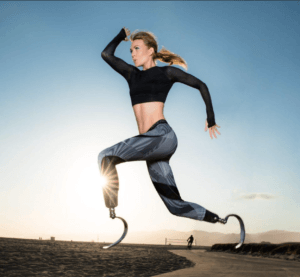 Amy Purdy is an American actress, model, para-snowboarder, motivational speaker, clothing designer, and author. Purdy is a 2014 Paralympic bronze medalist, 2018 Paralympics silver medalist, and co-founder of Adaptive Action Sports. Purdy was born in Las Vegas in 1979.
Amy Purdy is an American actress, model, para-snowboarder, motivational speaker, clothing designer, and author. Purdy is a 2014 Paralympic bronze medalist, 2018 Paralympics silver medalist, and co-founder of Adaptive Action Sports. Purdy was born in Las Vegas in 1979.
When she was 19 years old, she contracted Neisseria meningitidis, a form of bacterial meningitis. The disease affected her circulatory system when the infection led to septic shock; both of her legs had to be amputated below the knee, she lost both kidneys, and her spleen had to be removed. Doctors gave Purdy a 2% chance of survival. Two years later, she received a kidney transplant from her father.
Purdy began snowboarding seven months after she received her prosthetic legs. About a year after her legs were amputated, she finished third in a snowboarding competition at Mammoth Mountain. Subsequently, she received a grant from the Challenged Athletes Foundation (CAF), a non-profit organization. Through this grant, she was able to compete in several snowboarding competitions in the U.S.
In 2003, Purdy was recruited by the CAF as spokesperson, and she moved to San Diego to be closer to the CAF headquarters. In San Diego, she continued her pre-amputee profession as a massage therapist. She also became involved in the modeling and acting industry. In February 2003, she played a model in a Madonna music video.[1] Later in 2003, Purdy started working for Freedom Innovations, a prosthetic feet manufacturer, as its “Amputee Advocate”.
She has gone on to co-found her own non-profit organization, Adaptive Action Sports, a chapter of Disabled Sports USA for individuals with physical disabilities who want to get involved in action sports (snowboarding, skateboarding, surfing) or art and music. In 2005, Purdy made her film debut in What’s Bugging Seth, a movie by Eli Steele. She was named one of ESPNW’s Impact 25 in 2014, and one of Oprah’s SuperSoul 100 visionaries and influential leaders in 2016.
